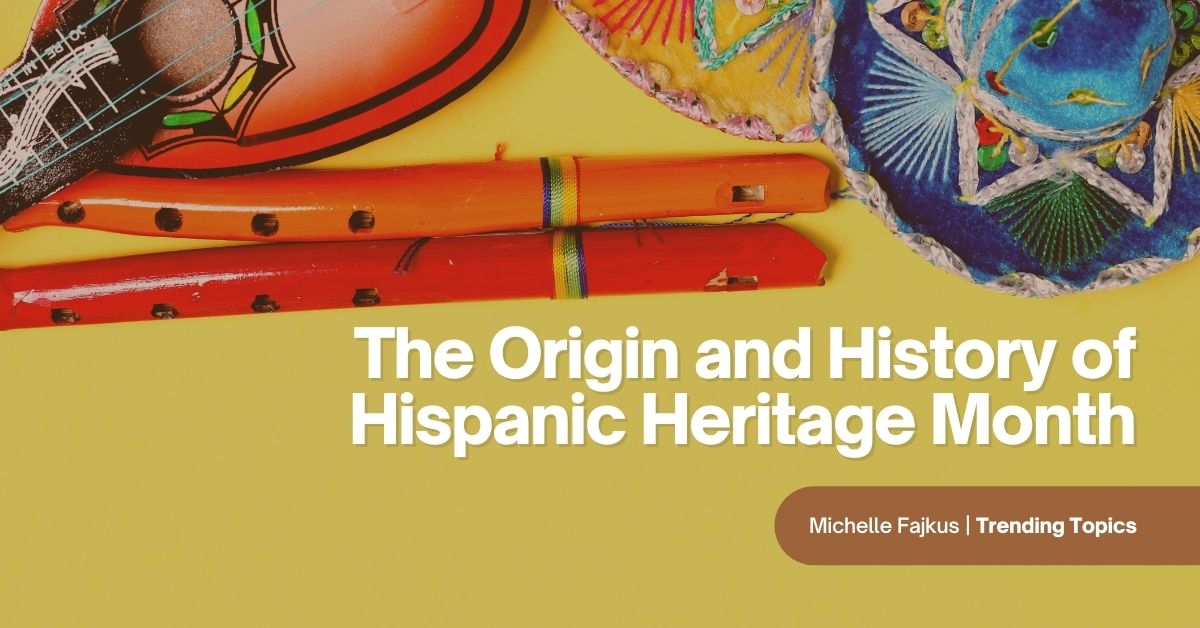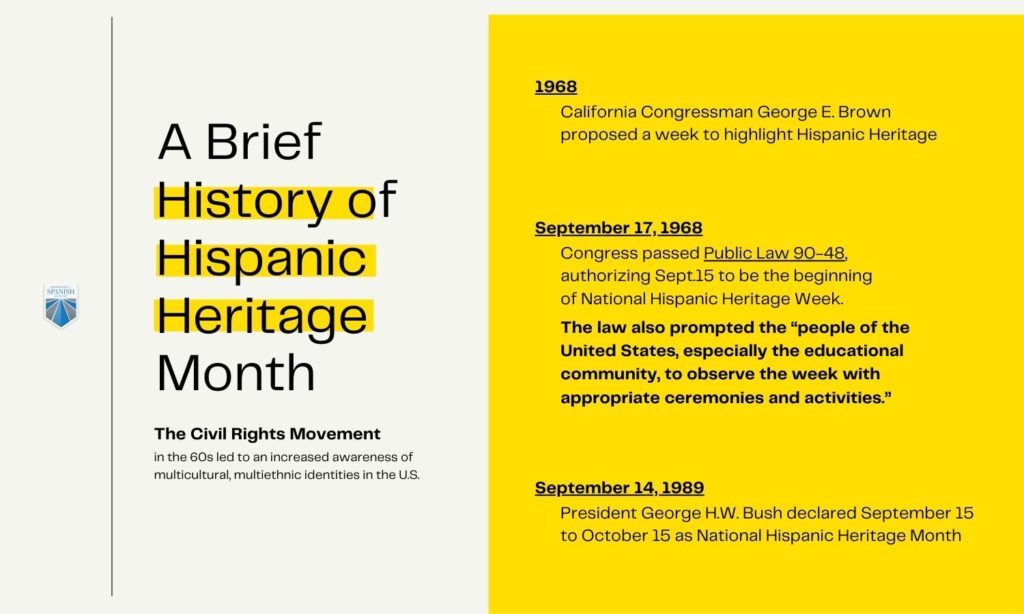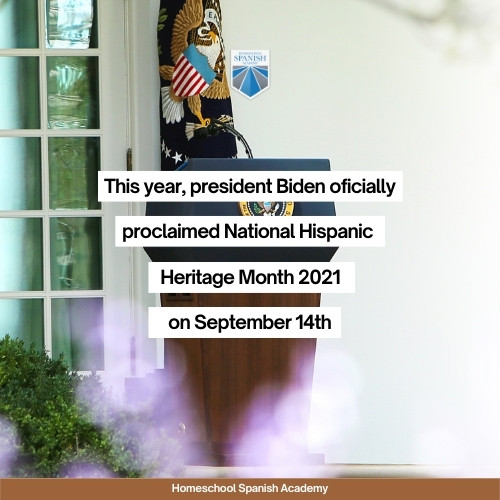
The Origin and History of Hispanic Heritage Month
Did you know that National Hispanic American Heritage Month is every September 15 to October 15 in the United States?
Why do we celebrate it?
To honor the heritage, cultures, and contributions of Hispanic and Latinx people. This also encompasses U.S. citizens whose ancestors are from Spain, Mexico, the Caribbean, Central America, and South America.
The terms Hispanic, Latino/a, and Latinx refer to a person’s culture or origin—as opposed to their race. In the 2020 Census, people were counted as Hispanic or Latino or Spanish if they identified as having “Mexican, Mexican American, Chicano, Puerto Rican, Cuban, or another Hispanic, Latino, or Spanish origin.”
Keep reading to learn about the origin, history, and importance of Hispanic Heritage Month and find out how people commemorate and celebrate it!
A Brief History of Hispanic Heritage Month

Today, multiple institutions promote National Hispanic Heritage Month. It’s a way to recognize all the Hispanic Americans, past and present, who’ve positively impacted the United States:
- The Library of Congress
- National Archives and Records Administration
- National Endowment for the Humanities
- National Gallery of Art
- National Park Service
- Smithsonian Institution
- United States Holocaust Memorial Museum
Why is Hispanic Heritage Month important?
It’s a period set aside for tribute to a specific population, similar to Black History Month in February and Gay Pride Month in June. During this month and throughout the year, organizations and individuals share stories of history, heritage, and accomplishments of Hispanic and Latin Americans.
So, how did it all begin?

National Hispanic Heritage Week
In fact, it began as a commemorative week—not a month. A California congressman named George E. Brown, who represented East Los Angeles and part of the San Gabriel Valley (both large Hispanic communities), proposed a week to highlight Hispanic Heritage in 1968.
During the 1960s, the Civil Rights Movement led to an increased awareness of multicultural, multiethnic identities in the U.S. That’s why there was a push to recognize the Latino community’s contributions.
On September 17, 1968, Congress passed Public Law 90-48. It authorized and requested the President to issue annual proclamations declaring September 15 as the beginning of National Hispanic Heritage Week. The law also prompted the “people of the United States, especially the educational community, to observe the week with appropriate ceremonies and activities.”
President Lyndon B. Johnson issued the first Hispanic Heritage Week presidential proclamation that day.
Significance of Dates
September 15 is a significant date, as it is Independence Day in five of the United States’ Central American neighbors, namely Costa Rica, El Salvador, Guatemala, Honduras, and Nicaragua, who jointly declared their independence from Spain on September 15, 1821.
Moreover, Mexico and Chile celebrate their independence days on September 16 and 18, respectively. Columbus Day or Día de la Raza, on October 12, also falls within Hispanic Heritage Month. In addition, Belize declared independence from Great Britain on September 21, 1981.
See also: 10 Children’s Books That Celebrate Hispanic Heritage
Expanding into National Hispanic Heritage Month
For the two decades from 1968 to 1988, Presidents Nixon, Ford, Carter, and Reagan all issued yearly proclamations, designating a week in mid-September to honor Hispanic Americans.
In 1987, U.S. Representative Esteban E. Torres of California proposed expanding the observance to a month rather than a week.
Torres proposed the extra time to allow the nation to “properly observe and coordinate events and activities to celebrate Hispanic culture and achievement.”
In 1988, Senator Paul Simon of Illinois submitted a similar bill that successfully passed Congress. President Ronald Reagan signed it into law on August 17, 1988.
When President George H.W. Bush declared September 15 to October 15 as National Hispanic Heritage Month on September 14, 1989, he remarked, “Not all of the contributions made by Hispanic Americans to our society are so visible or so widely celebrated. However, Hispanic Americans have enriched our nation beyond measure with the quiet strength of closely-knit families and proud communities.”
Every subsequent president of the United States (Clinton, Bush, Obama, Trump, and Biden) have made annual National Hispanic Heritage Month proclamations.
How to Celebrate Hispanic Heritage Month
Since 1989, the United States commemorates Hispanic Heritage Month through festivals, art exhibits, school events, community gatherings, and more. This year, President Biden officially proclaimed National Hispanic Heritage Month 2021 on September 14th. He noted that “the Hispanic-American community has left an indelible mark on our government, culture, and economy.”

Due to the pandemic, the 2020 Hispanic Heritage Month was predominantly virtual, and the theme was “Hispanics: Be Proud of Your Past, Embrace the Future.” The theme in 2021 is “Esperanza: A Celebration of Hispanic Heritage and Hope.”
The official website maintains a calendar of featured activities across the country, such as concerts, festivals, and parades.
And Spanish speakers, learners, and enthusiasts celebrate Hispanic Heritage Month in their homes and local communities with a variety of activities, from enjoying typical foods from Spain and Latin America to watching Spanish-language films and series. Contribute to the conversation on social media by using the hashtag #HispanicHeritageMonth.
For more fun suggestions, check out 10 Creative Ways to Celebrate Hispanic Heritage Month in 2021.
Happy Hispanic Heritage Month!
Learn Spanish to Celebrate Hispanic Heritage
According to the Census Bureau, the U.S. Hispanic population was 60.6 million in mid-2019, making people of Hispanic origin the nation’s largest ethnic or racial minority. That’s 18.5% of the nation’s total population. What’s more, approximately 53 million people speak Spanish in the U.S. You may be surprised to learn that the U.S. is the second-largest Spanish-speaking country in the world today. According to CNN, 41 million native Spanish speakers in the United States speak Spanish in their homes.
Whether you’re a beginner looking to start from scratch or an experienced student who wants to improve your language skills and attain fluency, our friendly, certified, native-speaking teachers at Homeschool Spanish Academy are ready to support your endeavors! To see for yourself how quickly you can take your Spanish to the next level, sign up now for a free trial class.

Do you love Hispanic culture? Check out our latest posts!
- Celebrating Culture and Joy: The Magic of Carnival in Spanish-Speaking Countries
- 15 Mouth-Watering National Dishes of Latin America
- Discovering The Mayan Languages
- The 10 Most Common Spanish Surnames in The U.S
- Everything About Mexican Christmas Traditions
- What Is the Hispanic Scholarship Fund? Is It Legit?
- A Spanish Guide to Thanksgiving Food Vocabulary
- How Did All Saints Day Celebrations Started?
- 10 Innovative Contemporary Latin American Artists Who Broke the Mold - February 16, 2023
- The Sweetest Guide to Valentine’s Day Vocabulary in Spanish - February 14, 2023
- 10 Famous Afro-Latinas Who’ve Made a Powerful Impact - February 9, 2023




